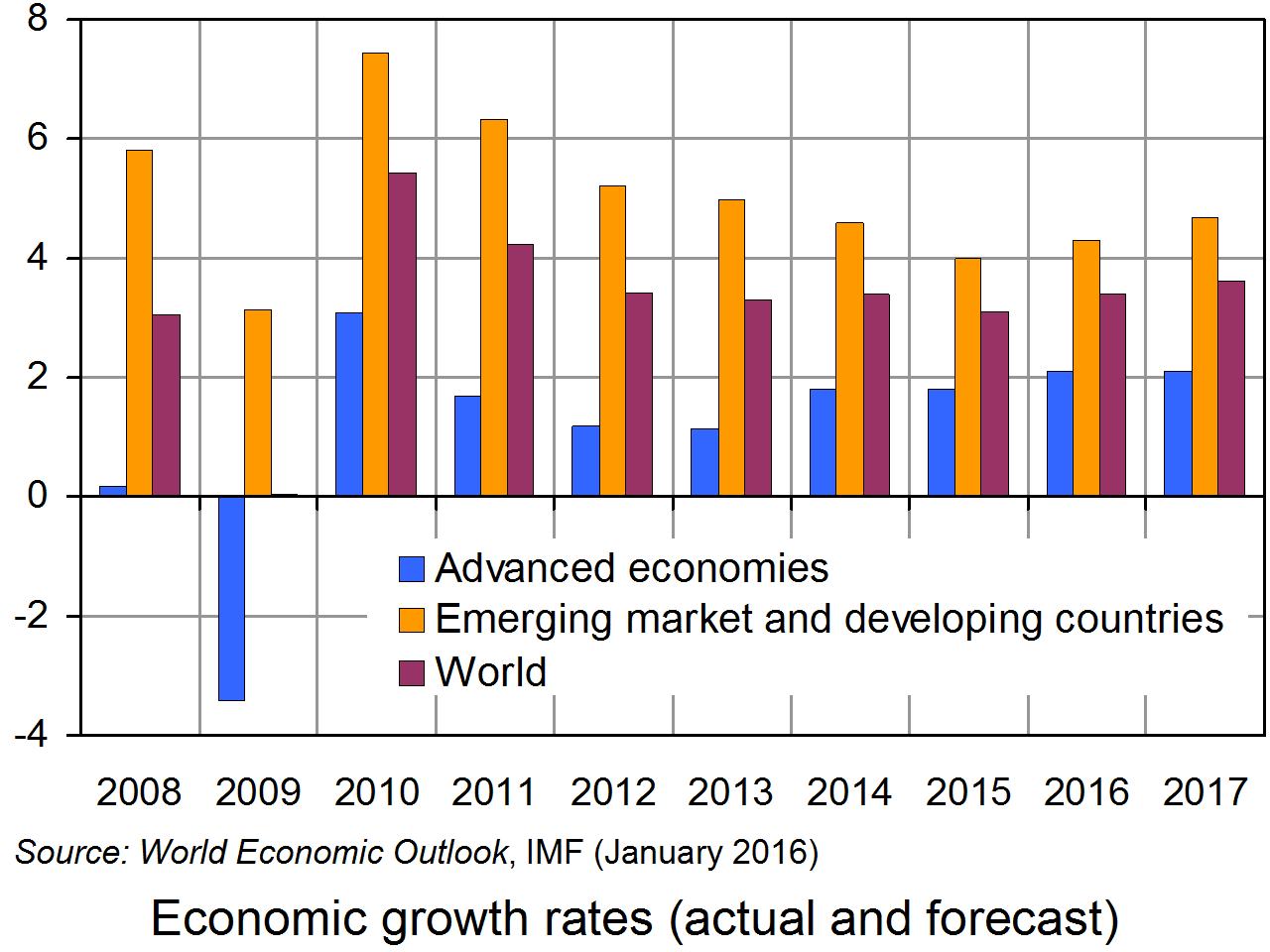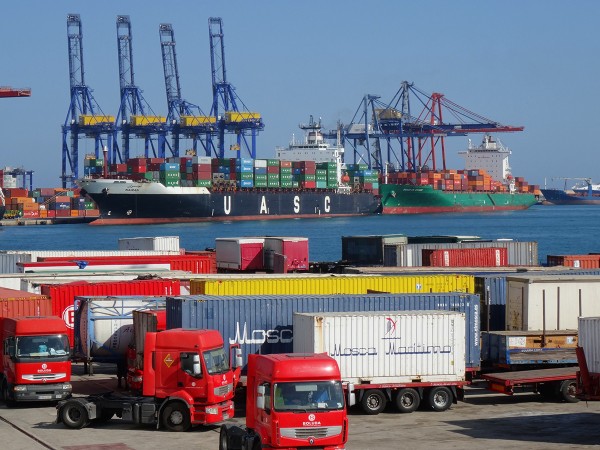 There is a lot of pessimism around about the state of the global economy and the prospects for more sustained growth. Stock markets have been turbulent; oil and other commodity prices have fallen; inflation has been below central bank targets in most countries; and growth has declined in many countries, most worryingly in China.
There is a lot of pessimism around about the state of the global economy and the prospects for more sustained growth. Stock markets have been turbulent; oil and other commodity prices have fallen; inflation has been below central bank targets in most countries; and growth has declined in many countries, most worryingly in China.
The latest worry, expressed by finance ministers at the G20 conference in Shanghai, is that UK exit from the EU could have a negative impact on economic growth, not just for the UK, but for the global economy generally.
But is this pessimism justified? In an interesting article in the Independent, Hamish McRae argues that there are five signs that the world economy is not doomed yet! These are:
|
|
| • |
There are more monetary and fiscal measures that can still be taken to boost aggregate demand. |
| • |
Despite some slowing of economic growth, there is no sign of a global recession in the offing. |
|
|
| • |
US and UK growth are relatively buoyant, with consumer demand ‘driving the economy forward’. |
| • |
Deflation worries are too great, especially when lower prices are caused by lower commodity prices. These lower costs should act to stimulate demand as consumers have more real purchasing power. |
| • |
Inflation may start to edge upwards over the coming months and this will help to increase confidence as it will be taken as a sign that demand is recovering. |
So, according to McRae, there are five things we should look for to check on whether the global economy is recovering. He itemises these at the end of the article. But are these the only things we should look for?
Five signs that the world economy is not doomed yet Independent, Hamish McRae (27/2/15)
Questions
- What reasons are there to think that the world will grow more strongly in 2016 than in 2015?
- What reasons are there to think that the world will grow less strongly in 2016 than in 2015?
- Distinguish between leading and lagging indicators of economic growth.
- Do you agree with McRae’s choice of five indicators of whether the world economy is likely to grow more strongly?
- What indicators would you add to his list?
- Give some examples of ‘economic shocks’ that could upset predictions of economic growth rates. Explain their effect.
 Deflation is currently a concern in the UK and across Europe. However, relative to Japan, the deflation concern is small. In Japan, deflation has been problematic for more than two decades and this has had significant implications for the Japanese economy.
Deflation is currently a concern in the UK and across Europe. However, relative to Japan, the deflation concern is small. In Japan, deflation has been problematic for more than two decades and this has had significant implications for the Japanese economy.
‘Abenomics’ has been in practice in Japan, as the Prime Minister, Shinzo Abe, has been trying to reflate the economy. Growth has been improving and the deflation concern appeared to be under control. However, GDP data now shows that the economy is once again declining and so with aggregate demand falling, this pushes down average prices across the economy and so the deflation risk re-emerges. This article from BBC News and another from The Guardian look at the economic policy known as ‘Abenomics’ and how the Japanese economy is faring.
Articles
Off target: Is it the end of ‘Abenomics’ in Japan? BBC News, Rupert Wingfield-Hayes (15/2/16)
Japan’s economy shrinks again as Abenomics is blown off course The Guardian, Justin McCurry (15/2/16)
Previous blogs
Japan’s deflation fears grow (update) (27/2/16)
Riding the Japanese roller coaster (15/2/16)
Japan’s interesting monetary stance as deflation fears grow (14/2/16)
Japan’s arrows missing their target (17/11/14)
Japan’s recovery (3/2/14)
Abenomics – one year on (16/12/13)
Japan’s three arrows (6/6/13)
Questions
- What are the key features of Japan’s ‘Abenomics’?
- Why is deflation such a concern? Surely falling prices are good for consumers and hence the economy.
- How has Japan been trying to reflate its economy and why has this failed?
- The yen is getting stronger, but how will this affect the Japanese economy? Use a demand and supply diagram to illustrate what has caused the value of the yen to fall and an aggregate demand and supply diagram to show the impact.
- Negative interest rates have been implemented in Japan. What does this mean for savers and borrowers and the economy?
- How do you think Japan’s stance on immigration and structural change is affecting its macroeconomy?
 Two surveys have been released looking at the quality of life in cities and the levels of happiness of their residents. The first is a three-yearly Eurobarometer survey by the European Commission focusing on 83 European cities/conurbations. This survey finds that, despite growing concerns about immigration, terrorism and stagnant real incomes, levels of satisfaction have remained stable since the 2012 survey. In all except six cities, at least 80% of respondents say that they are satisfied to live in their city. The highest scores (above 98%) are in the north of Europe.
Two surveys have been released looking at the quality of life in cities and the levels of happiness of their residents. The first is a three-yearly Eurobarometer survey by the European Commission focusing on 83 European cities/conurbations. This survey finds that, despite growing concerns about immigration, terrorism and stagnant real incomes, levels of satisfaction have remained stable since the 2012 survey. In all except six cities, at least 80% of respondents say that they are satisfied to live in their city. The highest scores (above 98%) are in the north of Europe.
The second is the 2016 Quality of Life Survey (an annual survey) by the consultancy firm, Mercer. This looks at cities worldwide, particularly from the perspective of employees of multinational companies being placed abroad. The survey found that the top ten cities by quality of life include seven in Europe, and that the five safest cities in the world are all in Europe.
 So what is it that makes the quality of life so high in many European cities, especially those in Germany, Austria, Switzerland, the Netherlands and Scandinavia? Is it that income per head is higher in these cities? In other words, is the quality of life related to GDP?
So what is it that makes the quality of life so high in many European cities, especially those in Germany, Austria, Switzerland, the Netherlands and Scandinavia? Is it that income per head is higher in these cities? In other words, is the quality of life related to GDP?
The answer is only loosely related to GDP. What seems more important is people’s income relative to other people and whether their income relative to other people is rising.
But people regard the quality of life in cities as depending on other factors than simple relative income. One factor common across all cities is household composition. People are least happy if they live on their own.
Other factors include: a feeling of safety; how well integrated different ethic and social groups are felt to be; the quality of public transport; the cleanliness of the city; health care provision and social services; the quality of schools and other educational establishments; sports facilities; cultural facilities; parks and other public spaces; the quality of shops, restaurants and other retail outlets;  the quality and price of housing; the ease of getting a job; trust in fellow citizens; environmental factors, such as air quality, noise, traffic congestion and cleanliness; good governance of the city. The top three issues are health services, unemployment and education and training.
the quality and price of housing; the ease of getting a job; trust in fellow citizens; environmental factors, such as air quality, noise, traffic congestion and cleanliness; good governance of the city. The top three issues are health services, unemployment and education and training.
Although cities with higher incomes per head can usually afford to provide better services, there is only a loose correlation between income per head and quality of life in cities. Many of the factors affecting quality of life are not provided by the market but are provided publicly or are part of social interaction outside the market.
Articles
Happiness in Europe The Economist (25/2/16)
Happiness in Europe: What makes Europeans happy? It depends on where they live The Economist (27/2/16)
Rating Europe’s Most and Least Happy Cities CityLab, Feargus O’Sullivan (9/2/16)
Europe’s Nicest Cities Aren’t Its Happiest Ones Bloomberg, Therese Raphael (2/2/16)
Vienna named world’s top city for quality of life The Guardian, Patrick Collinson (23/2/16)
Vienna named world’s best city to live for quality of life, but London, New York and Paris fail to make top rankings Independent, Loulla-Mae Eleftheriou-Smith (23.2.16)
The world’s most liveable cities: London and Edinburgh rank in top 50 The Telegraph, Soo Kim (23/2/16)
Reports
Quality of Life in European Cities 2015 Flash Eurobarometer 41 (January 2016)
Quality of Life in European Cities 2015: Individual Country Reports Flash Eurobarometer 41 (January 2016) (This may take a short while to download.)
Quality of life in European Cities 2015: Data for Research Flash Eurobarometer 41 (January 2016)
2016 Quality of Living Rankings Mercer (23/2/16)
Western European Cities Top Quality of Living Ranking Mercer, Press Release (23/2/16)
Questions
- Why, do you think, is the quality of life is generally higher in (a) most northern European cities than most southern and eastern European ones; (b) most European cities rather than most north American ones?
- To what extent is (a) absolute real income per head; (b) relative real income per head an indicator of quality of living in cities?
- Why, do you think, are Italians less satisfied with the quality of life in their cities than residents of other western European countries?
- What factors affect your own quality of living? To what extent do they depend on the city/town/village/area where you live?
- Look at the list of factors above that affect quality of life in a given city. Put them in order of priority for you and identify any other factors not listed. To what extent do they depend on your age, your background, your income and your personal interests and tastes?
- Identify a particular city with which you are relatively familiar and assume that you were responsible for allocating the city’s budget. What would you spend more money on, what less and what the same? Provide a justification for your allocation.
- Discuss the following passage from the Bloomberg article: “What is striking is that there appears to be a correlation between those who report high levels of satisfaction and those who view foreigners in their city as an advantage. Conversely, respondents who complained loudest about transportation, public services, safety and other issues tended to view the presence of foreigners far less favorably.”
 Sustained economic growth in Japan remains elusive. Preliminary Quarterly Estimates of GDP point to the Japanese economy having contracted by 0.4 per cent in the final quarter of 2015. This follows on from growth of 0.3 per cent in the third quarter, a contraction of 0.3 per cent in the second and growth of 1 per cent in the first quarter. Taken as a whole output in 2015 rose by 0.4 per cent compared to zero growth in 2014. The fragility of growth means that over the past 20 years the average annual rate of growth in Japan is a mere 0.8 per cent.
Sustained economic growth in Japan remains elusive. Preliminary Quarterly Estimates of GDP point to the Japanese economy having contracted by 0.4 per cent in the final quarter of 2015. This follows on from growth of 0.3 per cent in the third quarter, a contraction of 0.3 per cent in the second and growth of 1 per cent in the first quarter. Taken as a whole output in 2015 rose by 0.4 per cent compared to zero growth in 2014. The fragility of growth means that over the past 20 years the average annual rate of growth in Japan is a mere 0.8 per cent.
 Chart 1 shows the quarter-to-quarter change in real GDP in Japan since the mid 1990s (Click here to download a PowerPoint of the chart). While economies are known to be inherently volatile the Japanese growth story over the past twenty or years so is one both of exceptional volatility and of repeated bouts of recession. Since the mid 1990s Japan has experienced 6 recessions, four since 2008.
Chart 1 shows the quarter-to-quarter change in real GDP in Japan since the mid 1990s (Click here to download a PowerPoint of the chart). While economies are known to be inherently volatile the Japanese growth story over the past twenty or years so is one both of exceptional volatility and of repeated bouts of recession. Since the mid 1990s Japan has experienced 6 recessions, four since 2008.
Of the four recessions since 2008, the deepest was that from 2008 Q2 to 2009 Q1 which saw the economy shrink by 9.2 per cent. This was followed by a recession from 2010 Q4 to 2011 Q2 when the economy shrunk by 3.1 per cent, then from 2012 Q2 to 2012 Q4 when the economy shrunk by 0.9 per cent and from 2014 Q2 to 2014 Q3 when output fell another 2.7 per cent. As a result of these four recessionary periods the economy’s output in 2015 Q4 was actually 0.4 per cent less than in 2008 Q1.
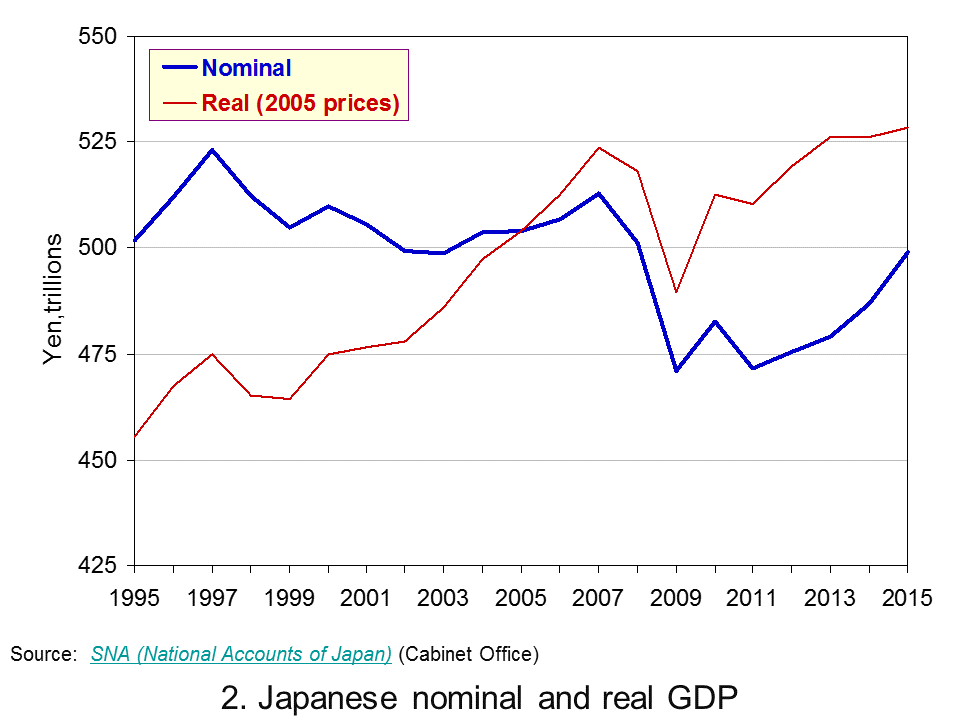 Chart 2 shows the annual levels of nominal (actual) and real (constant-price) GDP in trillions of Yen (¥) since 1995. (Click here to download a PowerPoint of the chart). Over the period actual GDP has fallen from ¥502 trillion to ¥499 trillion (about £3 trillion at the current exchange rate) while GDP at constant 2005 prices has risen from ¥455 trillion to ¥528 trillion.
Chart 2 shows the annual levels of nominal (actual) and real (constant-price) GDP in trillions of Yen (¥) since 1995. (Click here to download a PowerPoint of the chart). Over the period actual GDP has fallen from ¥502 trillion to ¥499 trillion (about £3 trillion at the current exchange rate) while GDP at constant 2005 prices has risen from ¥455 trillion to ¥528 trillion.
Chart 2 reveals an interesting phenomenon: the growth in real GDP at the same time as a fall in nominal GDP. So why has the actual value of GDP fallen slightly between 1995 and 2005? The answer is quite simple: deflation.
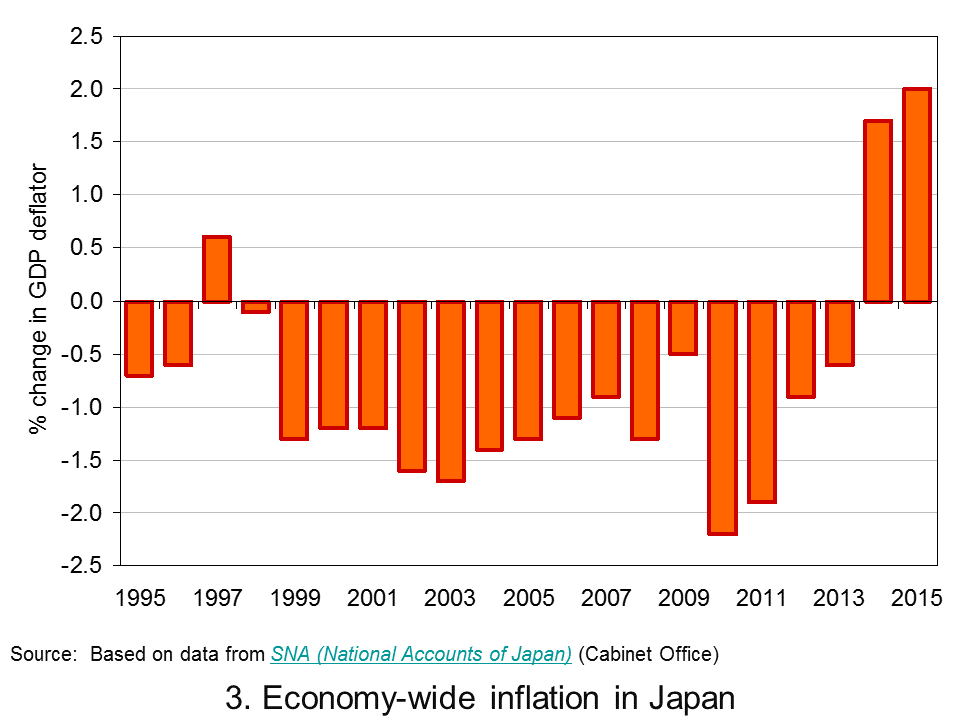 Chart 3 shows a protracted period of economy-wide deflation from 1999 to 2013. (Click here to download a PowerPoint of the chart). Over this period the GDP deflator fell each year by an average of 1.0 per cent. 2014 and 2015 saw a pick up in economy-wide inflation. However, the quarterly profile through 2015 shows the pace of inflation falling quite markedly. As we saw in Japan’s interesting monetary stance as deflation fears grow, policymakers are again concerned about the possibility of deflation and the risks that poses for growth.
Chart 3 shows a protracted period of economy-wide deflation from 1999 to 2013. (Click here to download a PowerPoint of the chart). Over this period the GDP deflator fell each year by an average of 1.0 per cent. 2014 and 2015 saw a pick up in economy-wide inflation. However, the quarterly profile through 2015 shows the pace of inflation falling quite markedly. As we saw in Japan’s interesting monetary stance as deflation fears grow, policymakers are again concerned about the possibility of deflation and the risks that poses for growth.
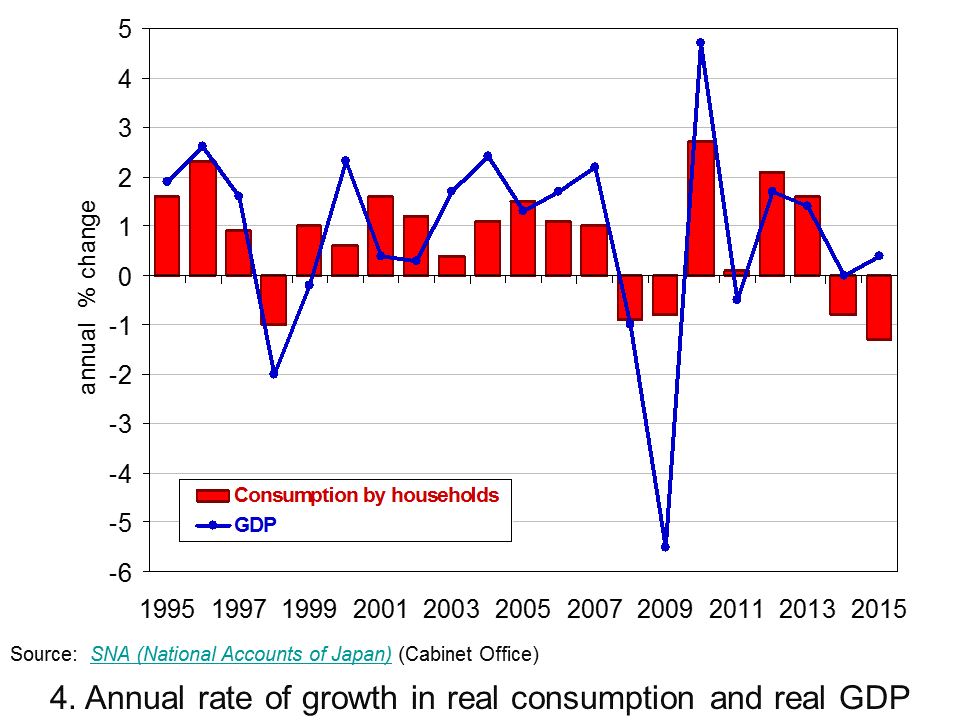 As Chart 4 helps to demonstrate, a significant factor behind the latest slowdown in Japan’s growth is household spending. (Click here to download a PowerPoint of the chart). In 2015 household spending accounted for about 57 per cent by value of GDP in Japan. In the last quarter of 2015 real household spending fell by 0.9 per cent while across 2015 as a whole real household spending fell by 1.3 per cent. This follows on from a 0.8 per cent decrease in spending by households in 2014.
As Chart 4 helps to demonstrate, a significant factor behind the latest slowdown in Japan’s growth is household spending. (Click here to download a PowerPoint of the chart). In 2015 household spending accounted for about 57 per cent by value of GDP in Japan. In the last quarter of 2015 real household spending fell by 0.9 per cent while across 2015 as a whole real household spending fell by 1.3 per cent. This follows on from a 0.8 per cent decrease in spending by households in 2014.
The recent marked weakening of household spending is a significant concern for the short term growth prospects of the Japanese economy. The roller coaster ride continues, unfortunately it appears that the ride is again downwards.
Data
Quarterly Estimates of GDP Japanese Cabinet Office
Japan and the IMF IMF Country Reports
Economic Outlook Annex Tables OECD
Articles
Japan’s economy contracts in fourth quarter BBC News, (15/2/16)
Japanese economy shrinks again, raising expectations of more stimulus Telegraph, Szu Ping Chan (15/2/16)
Japan’s economy shrinks again as Abenomics is blown off course Guardian, Justin McCurry (15/2/16)
Japan’s economy contracts in latest setback for Abe policies New Zealand Herald, (15/2/16)
Japan’s ‘Abenomics’ on the ropes as yen soars, markets plunge Daily Mail, (15/2/16)
Japan economy shrinks more than expected, highlights lack of policy options CNBC, Leika Kihara and Tetsushi Kajimoto (15/2/16)
Questions
- Why is the distinction between nominal and real important in analysing economic growth?
- How do we define a recession?
- Of what importance is aggregate demand to the volatility of economies?
- Why are Japanese policymakers concerned about the prospects of deflation?
- What policy options are available to policymakers trying to combat deflation?
- Why is the strength of household consumption important in affecting the path of an economy?
- Why has Japan experienced an increase in real GDP but a fall in nominal GDP between 1995 and 2015?
 In our recent blog constructing growth without production: The UK growth paradox we saw that the provisional estimate of economic growth in the UK in the final quarter of 2015 was 0.5 per cent. This was buoyed by service sector growth of 0.7 per cent. Meanwhile, construction sector output was estimated to have fallen by 0.1 per cent and production in the production industries by 0.2 per cent. The ONS Index of Production released on 11 February suggests the decline in production activity in the final quarter might have been has much as 0.5 per cent further pointing to unbalanced industrial growth.
In our recent blog constructing growth without production: The UK growth paradox we saw that the provisional estimate of economic growth in the UK in the final quarter of 2015 was 0.5 per cent. This was buoyed by service sector growth of 0.7 per cent. Meanwhile, construction sector output was estimated to have fallen by 0.1 per cent and production in the production industries by 0.2 per cent. The ONS Index of Production released on 11 February suggests the decline in production activity in the final quarter might have been has much as 0.5 per cent further pointing to unbalanced industrial growth.
 The production industries today account for about 15 per cent of UK output which is small in comparison to the roughly 79 per cent from service-sector industries. Chart 1 shows the quarterly rate of growth in UK industrial production since the 1980s. (Click here for a PowerPoint of the chart). Over this period the average quarterly rate of growth in industrial output has been a mere 0.1 per cent compared with 0.5 per cent for total economic output and 0.7 per cent for the service sector. As a result, the importance of the production industries as a driver of economic output has declined.
The production industries today account for about 15 per cent of UK output which is small in comparison to the roughly 79 per cent from service-sector industries. Chart 1 shows the quarterly rate of growth in UK industrial production since the 1980s. (Click here for a PowerPoint of the chart). Over this period the average quarterly rate of growth in industrial output has been a mere 0.1 per cent compared with 0.5 per cent for total economic output and 0.7 per cent for the service sector. As a result, the importance of the production industries as a driver of economic output has declined.
Across 2015 industrial production rose by 1 per cent while the total output of the economy grew by 2.2 per cent. Industrial output comprises four main components. Of these, output from mining and quarrying grew in 2015 by 6.6 per cent, water, sewerage and waste management by 3.1 per cent, electricity, gas, steam and air conditioning by 0.3 per cent, while manufacturing output contracted by 0.2 per cent.
 Chart 2 shows the path of industrial output since 2006. (Click here for a PowerPoint of the chart). In particular, it allows us to analyse the effect of the financial crisis and the global economic downturn. Whereas the total output of the economy surpassed its 2008 Q1 peak in 2013 Q2, driven by the service sector, total industrial output in 2015 Q4 remains 9.9 per cent below its 2008 Q1 level. Among its component parts, output in mining and quarrying is 31 per cent lower, electricity, gas, steam and air conditioning output is 12.2 per cent lower and manufacturing 6.5 per cent lower. Only the output of water, sewerage and waste management is greater – some 7.4 per cent higher.
Chart 2 shows the path of industrial output since 2006. (Click here for a PowerPoint of the chart). In particular, it allows us to analyse the effect of the financial crisis and the global economic downturn. Whereas the total output of the economy surpassed its 2008 Q1 peak in 2013 Q2, driven by the service sector, total industrial output in 2015 Q4 remains 9.9 per cent below its 2008 Q1 level. Among its component parts, output in mining and quarrying is 31 per cent lower, electricity, gas, steam and air conditioning output is 12.2 per cent lower and manufacturing 6.5 per cent lower. Only the output of water, sewerage and waste management is greater – some 7.4 per cent higher.
The data point to the industrial composition of UK remaining heavily skewed towards the service sector and, hence, to service-sector industries driving economic growth. A key talking point is the extent to which this matters. On one hand we might point to the deindustrialisation captured by the data. This has had profound implications for certain regions of the United Kingdom and in particular for living standards in certain communities. Industrial change poses challenges for the UK labour force and for policymakers trying to affect the skills of workers needed in a changing economy. It has had a profound impact on the country’s balance of trade in goods: we consistently run a balance of trade deficit in goods. On the other hand we might argue that the UK does services well. We might be said to have a comparative advantage in this area. Whatever, your view point the latest industrial production data show the fragility of UK industrial output.
Data
Index of Production Dataset December 2015 Office for National StatisticsIndex of Production, December 2015 Office for National Statistics
Articles
UK industrial production shrank in 2015 Guardian, Phillip Inman (10/2/16)
December UK industrial output falls sharply BBC News, (10/2/16)
Manufacturing output fall dents UK growth hope Sky News, (10/2/16)
Industrial production’s worst monthly fall since 2012 Belfast Trelegraph, Holly Williams (11/2/16)
GDP growth picks up to 0.5% but only the services sector comes to the party Independent, Ben Chu (29/1/16)
Questions
- What is meant by industrial production? How does it differ from the economy’s total output?
- Would you expect the index of production to be less or more volatile than total output? Explain your answer.
- What factors might explain the volatility of industrial production?
- Do the different rates of growth across the industrial sectors of the UK matter?
- Discuss the economic issues that might arise as the industrial composition of a country changes.
- Why is the distinction between nominal and real important when analysing economic growth?
 There is a lot of pessimism around about the state of the global economy and the prospects for more sustained growth. Stock markets have been turbulent; oil and other commodity prices have fallen; inflation has been below central bank targets in most countries; and growth has declined in many countries, most worryingly in China.
There is a lot of pessimism around about the state of the global economy and the prospects for more sustained growth. Stock markets have been turbulent; oil and other commodity prices have fallen; inflation has been below central bank targets in most countries; and growth has declined in many countries, most worryingly in China.